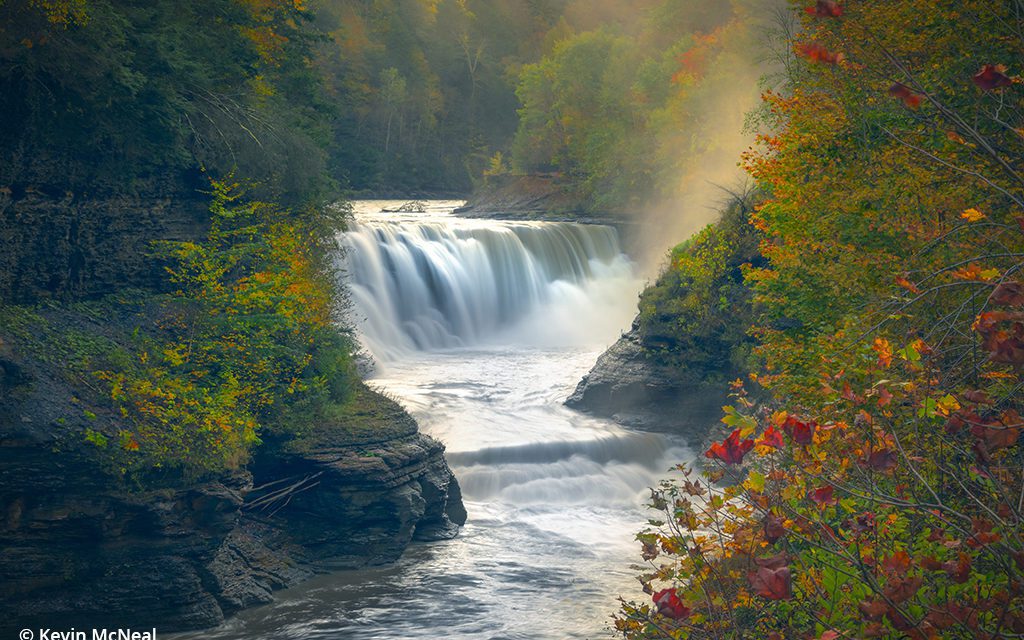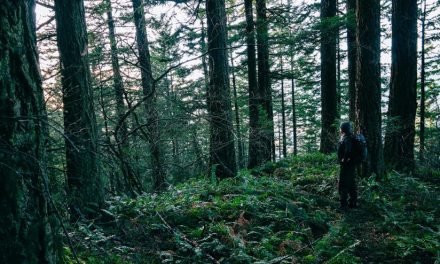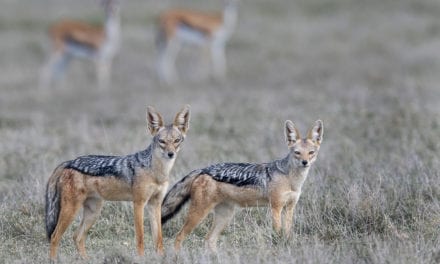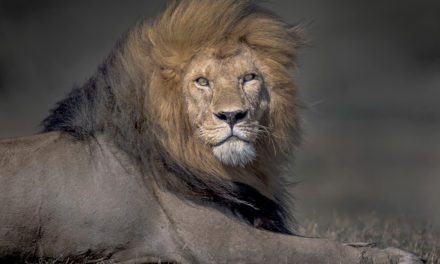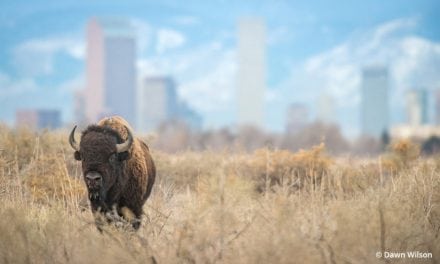There is nothing quite like the change of seasons from summer to fall. The days become shorter, the nights grow longer, and there’s a nip in the air. It’s the start of a special time for photographers—the arrival of autumn colors. Cooler temperatures and shifts in atmospheric conditions are what prompt foliage to present brilliant hues of red, orange and yellow across the landscape. The flood of vivid colors is an opportunity for bold photographs—but can also be an overwhelming and challenging subject. Let’s consider some creative ways to bring out the best in your fall photography, as well as some of my favorite locations to try these techniques.
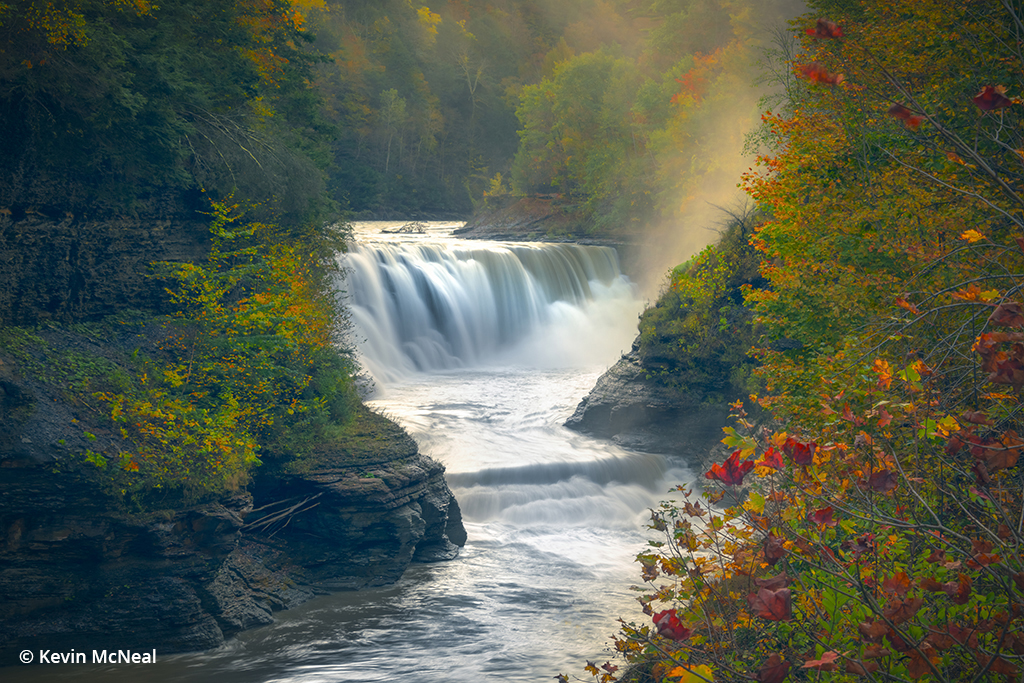
Letchworth State Park, upstate New York. A rush of water makes its way down Genesee River in Letchworth State Park, where fall color lines the banks of the river and frames the falls in the background. From a composition perspective, the s-curve arrangement leads the viewer through the image from front to back.
Planning Your Fall Photography Trip
First, it’s essential to do some research. Before you head out on location, look for autumn images that you connect with visually and emotionally on the internet and in books. Once I know what moves me in a picture, I can then identify that concept in the scenes I encounter. Research allows me to find locations that I want to photograph.
Knowing where to go is the first piece of the puzzle, but equally important is timing. Research timing for past peak fall colors in the area you want to visit. Although it changes from year to year, looking at previous years can be very helpful in narrowing the timeline.
The peak of colors varies from state to state dramatically, and it can also be very different from town to town. Checking the forecast for temperatures and weather several weeks before can help predict better outcomes for color timing. It’s helpful to know the elevations of the locations where you plan to shoot, as fall colors arrive earlier at higher elevations due to the cooler temperatures.
Use A Polarizing Filter
One of the most critical pieces of equipment for capturing fall color images is a circular polarizer. Use of a circular polarizer applies to any scene and is an excellent way to maximize color saturation. Circular polarizers can accentuate contrast and allow the colors to “pop.”
Polarizers can be especially effective with blue skies on clear days, making the fall foliage stand out against the deep blue skies. On cloudy and overcast days, a circular polarizer is a must-have for removing unwanted glare that reflects off foliage—which can be difficult or impossible to fix in post-processing.
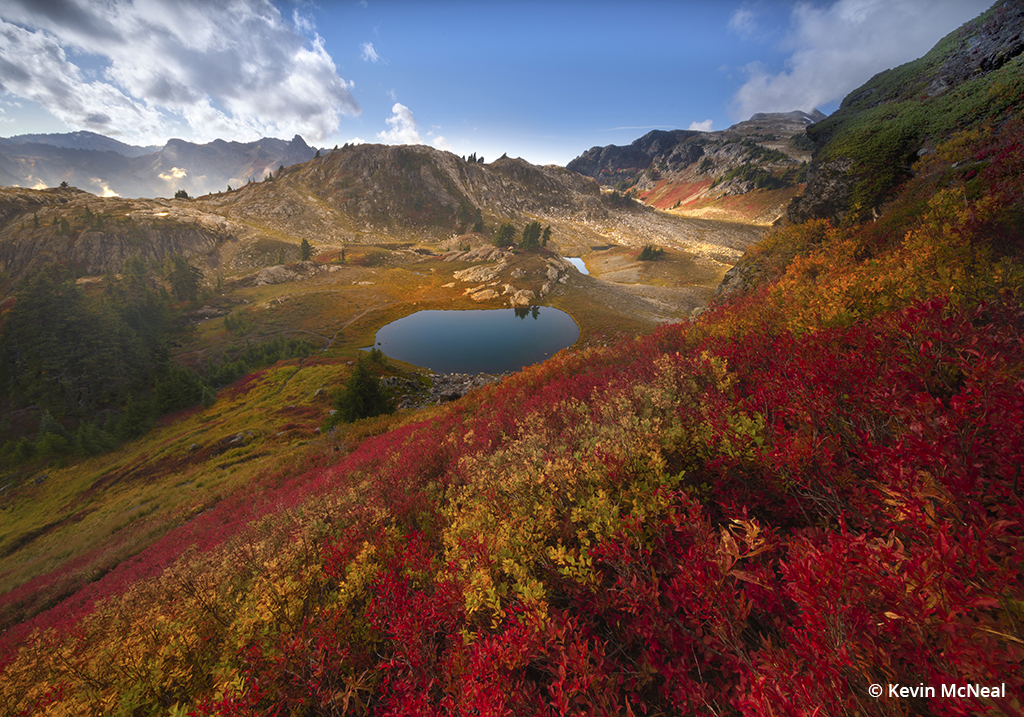
Yellow Aster Butte Trail, North Cascades National Park, Washington. This trail is one of the many beautiful fall color hikes in the North Cascades. The inclusion of the blue lake in this photograph creates the color harmony. The foreground red colors lead through the image and into the cooler tones of the background. This helps establish depth in the composition by using colors to lead the viewer into the frame.
One often-overlooked reason for using a circular polarizer is to achieve slower shutter speeds when photographing scenes with water. These filters reduce light transmission by about two stops, allowing longer exposure times to render moving water with a silky, moody effect.
While a standard circular polarizer is useful year-round, a warming polarizer is an option to consider this time of year for a nice boost to the warmer-tone colors in a scene, accentuating autumn hues.
Include Water Elements In Your Fall Photos
When it comes to subjects for your fall color photos, the list can be endless. It is vital to choose a handful of those subjects and focus on how to photograph those creatively. Think “outside the box” for unusual ways to present your fall color story.
My favorite theme when it comes to fall color photography is water. When I explore locations, I look for bodies of water, especially lakes. Lakes in the early morning can be great for reflections and rising mist. Because of the cooler temperatures, morning mist is relatively common and can add an atmospheric element to your images that contrasts with the bold colors.
When photographing lakes, look for reflections. Inlets and coves protect from the wind and allow the water to remain still. The mirroring of color on a lake’s surface adds to the overall impact of the image.
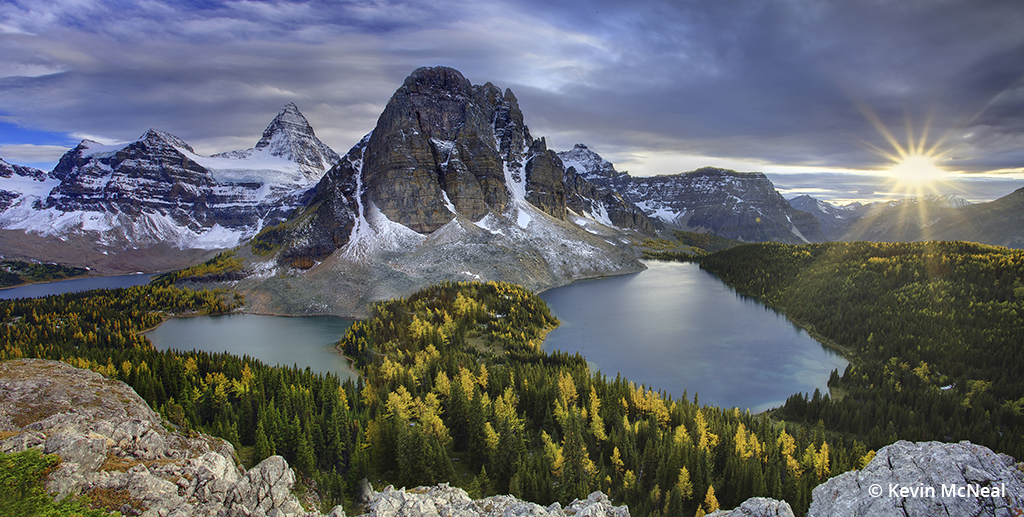
Mount Assiniboine Provincial Park, Canada. A short hike to the top of Nub Peak overlooks Mount Assiniboine and the yellow larches in September. From a creative perspective, I choose a panorama view to capture the vastness and all the elements in the scene. I used the partially blocked sunstar to provide some illumination and warmth on the right side of the frame to balance the cooler tones on the left side. The placement of the yellow larches provides a nice contrast in the overall color harmony.
Another favorite subject when it comes to photographing the element of water is water in motion: streams, creeks, rivers and waterfalls. These are especially photogenic after the peak of fall color when the leaves have fallen on the ground and alongside the water. To achieve the smooth look of longer exposures, it’s helpful to have a neutral density filter to reduce the light and permit slower shutter speeds of perhaps several seconds. This effect gives the water a smooth, silky look that adds a surreal detail to your autumn images. Areas with leaves floating on top of the water can create swirling patterns during long exposures to add foreground interest to your image.
Angle Of Light Is Important For Fall Photography
Capturing the right angle of light is imperative to boost colors, and this depends on where and how illumination is falling in your scene. It is the tool that gives shape and texture to your subject.
I highly recommend backlighting for a unique effect. The transparency of fall foliage is on full display when light shines through the leaves and provides illumination around its edges. Shooting fall colors scenes that are backlit can be challenging but is an effective way to capture bold, vibrant color in the landscape.
Side-lighting can also be very useful for showcasing your subject. For this technique, position yourself so that light comes from an angle of roughly 90 degrees to the camera. Side-lighting is very good for conveying shape and form and gives dimension to your compositions with a sense of depth.
My favorite technique, although perhaps the most difficult to use successfully, is shooting directly into the sun during sunrise or sunset. It is critical to use the elements in the scene to partially block or diffract the light when photographing into the sun. I try to frame the sun so that only the sun’s rays are in the image. This gives a warm, cinematic appearance to the image and reveals something magical on the horizon. To create a nice “sunstar” effect, use a small aperture like ƒ/22.
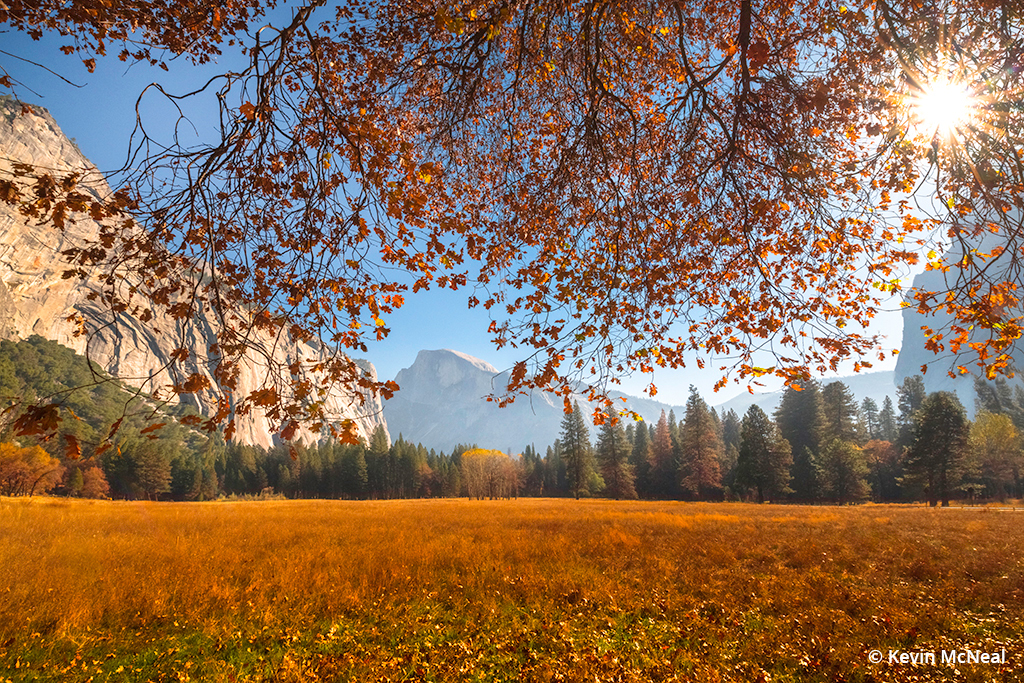
Yosemite National Park. The hanging fall foliage frames Half Dome in the distance as the sun peeks through. It was important when framing this shot not to block Half Dome. I positioned the sun to be partially blocked by the fall foliage to capture a sunstar at ƒ/22.
Use Exposure Bracketing
Whenever I photograph fall colors, I find I can get the best colors and detail from a scene when I bracket my exposures, especially near the golden hour when the light can be very harsh in terms of contrast. I take a minimum of three exposures on a tripod. One exposure is two stops underexposed, the next is a “correct” exposure, and the last is two stops overexposed. When processing these files, I combine them into one final image that contains all the information from the three images. The benefit of doing exposure bracketing is the flexibility it allows you when editing to open up shadows without noise, avoid blown highlights from overexposure, and enhance colors without posterization.
Shoot In “Golden Hour” Light
The magical hours of sunrise and sunset are some of the best times to photograph autumn scenes. Due to the low light and position of the sun, the light is warm and diffused and provides a soft glow to the landscape.
Look for compositions that include cloud patterns in the sky at this time of day. The combination of color in the clouds can add harmony to your composition and make a more cohesive image. Watch for cloud formations that mimic or complement the other shapes in your scene.
So, does this mean you shouldn’t photograph on an overcast day? Not at all! Often with overcast skies comes changes in weather and temperature that can lead to atmospheric conditions like rising mist from a water source, fog in a forest, or occasionally rays of sun breaking through the mist—all of which, as we’ve already discussed, can add interest to a fall color scene.
Composition Tips For Fall Photography
The goal of every photographer is to tell a story that connects with your viewer. One of the ways to achieve this is through thoughtful composition. Shoot fall colors from unusual angles to give the scene a different perspective.
Most autumn images are taken from eye level. Don’t be afraid to change that. Trying shooting fall foliage from the ground level, for example. I describe the concept as seeing the world as a bug would. The landscape takes on a completely different look from the ground. Combine this perspective with a wide-angle lens to accentuate the size of objects and add depth to the image. The wide angle exaggerates foreground elements, bringing the viewer closer to details. Use elements in the foreground to lead into or frame the scene. Fallen leaves at the edge of the frame can make for great leading lines.
Wide angles are an obvious choice but also try photographing the scene from a distance with a telephoto lens. This is an excellent method for isolating objects, allowing for simple but effective arrangements of color and form.
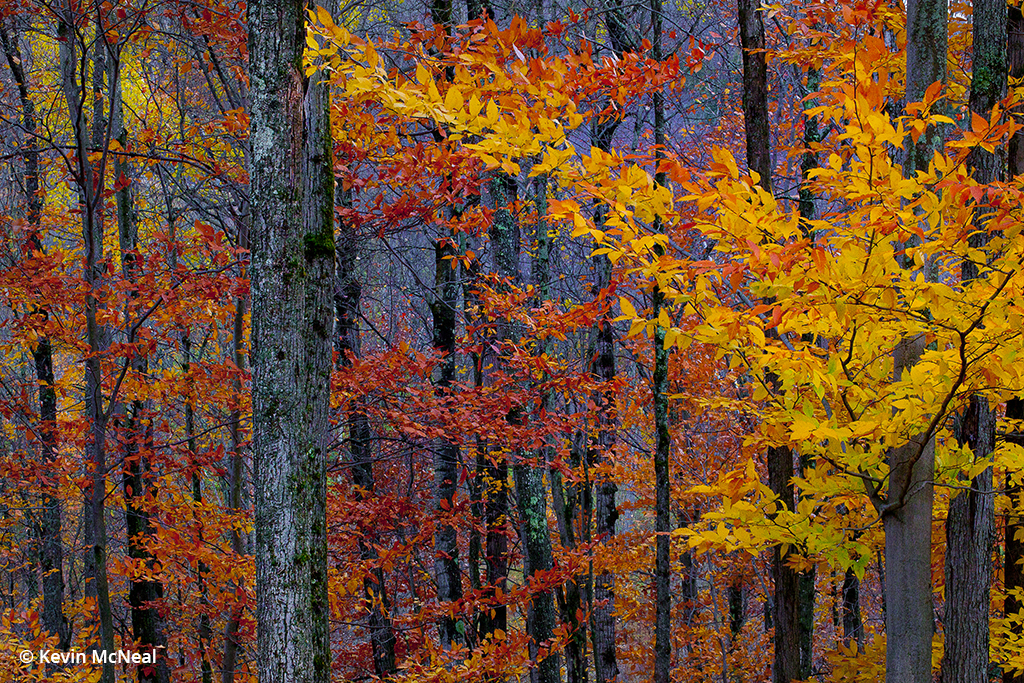
Laurentian Mountains, Quebec, Canada. The colorful forests of the Laurentian mountains in the higher elevations of Quebec are an idyllic autumn destination. In this composition, the cooler tones of the trees anchor the warmer tones of the fall foliage, and the repeating vertical lines provide a sense of organization.
Another option for a change of viewpoint is to find higher ground above your subject and shoot looking down. Or, if you have access to a drone, its elevated view allows you to isolate patterns that can only be viewed from the air.
Macro lenses are also an excellent choice. A single leaf has a world of textures and patterns to discover. A macro lens enables you to explore these and create abstract compositions that present the subject from yet another perspective.
Use a combination of these lens types and approaches to composition, and you’ll come away with a portfolio of images that tell the story of fall color from many angles.
Create Color Harmony In Your Framing
Fall color images are predominantly warm-tone colors. A carefully composed image presents those colors arranged in a harmonious way. Each color has weight, and when composing a scene, I look for complementary colors to balance the bright autumn hues. Blue skies and evergreen foliage are a pleasing counterweight to warm tones of red, yellow and brown. Composing your frame so that these contrasting colors are dispersed evenly through your frame allows the viewer’s eye to move through the photograph without getting stuck in one part of the image.
Favorite Places For Fall Photography
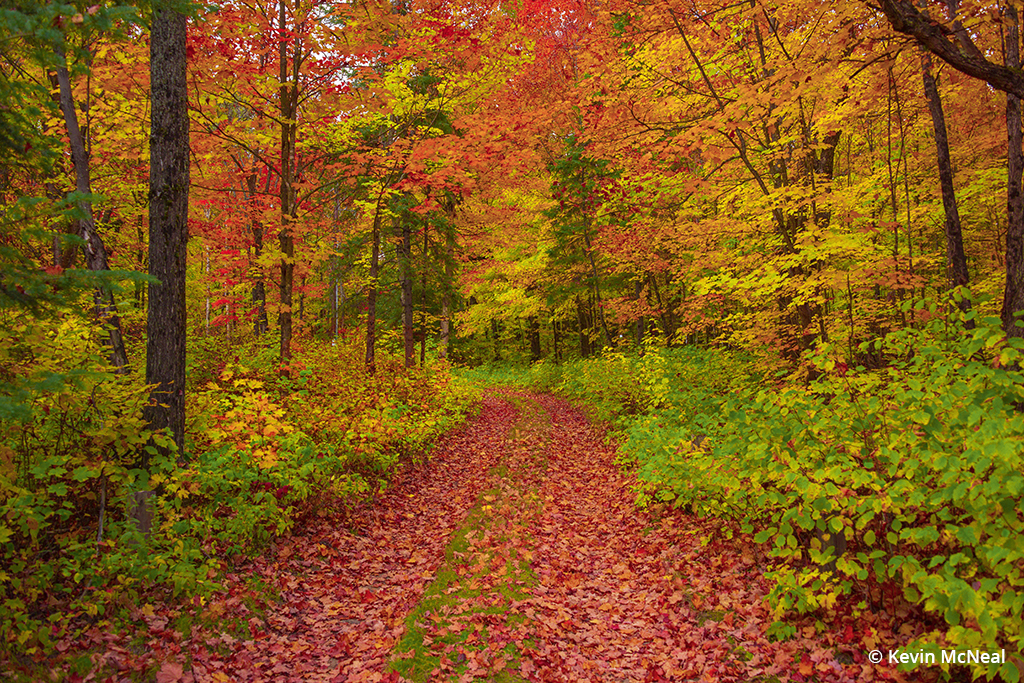
Algonquin Provincial Park, Ontario, Canada. The converging lines of the foreground path lead the viewer through the image. This type of composition works well for autumn images as it gives the viewer the sense they are walking right into the scene.
The Canadian Rockies
The Canadian Rockies in the provinces of British Columbia and Alberta encompass some of the most scenic locations in the world. Icefields Parkway is a highway that makes for an ideal place to start. Between the towns of Banff and Jasper lie photo opportunities around every corner. In the fall season, the turquoise lakes are surrounded by golden yellow aspens in the valleys. Beautiful larches can be found higher in the subalpine meadows.
The combination of these colors with the larger-than-life mountains in the background make for stunning autumn images. Make sure to include more days to explore the less-visited locations such as Yoho and the Kananaskis Country for fall color aspens. Bring a telephoto lens for all the wildlife such as the elk that can be photographed along the main highways.
The fall season in the Canadian Rockies typically begins in the first weeks of September and can extend into the beginning of October when the first snow usually arrives.
Atlantic Canada
The provinces of Quebec and Nova Scotia are some of the most picturesque locations for autumn colors, with an abundance of golden yellows and fire reds. A favorite spot is the Cape Breton Highlands in Nova Scotia. Known for vibrant reds and oranges, it boasts viewpoints that can be seen of the forest canopies from one of the many paths and roadways that lead through the middle of this national park. Cape Breton hosts several reflecting lakes, winding rivers and tucked-away waterfalls. There is plenty to see and do here. With a variety of hiking trails, this favorite autumn spot is the place to be.
Another gorgeous area within one day of travel from Cape Breton Highlands is the Laurentian mountains in the province of Quebec. The vibrancy of red colors comes from the well-known sugar maple trees. Located in southern Quebec, fall foliage in the area showcases some of the best color variety anywhere. The fall color palette displays dazzling colors in dense forests of yellow birch and American beech. Consider a visit to the town of Mont Tremblant during the middle of September for its annual color festival.
Upstate New York
With so many photogenic locations so close in proximity to one another, it’s hard not to have this region as a favorite. Upstate New York is known for its red and oranges that dominant the fall foliage across the state. What makes upstate New York unique when it comes to autumn is the variety of driving routes available. The winding roads through the mountains offer a range of scenic vistas—around every corner lie stunning views. If you enjoy hiking and walking in nature, there are over 900 different waterfalls, as well as various kinds of cascades and gorges.
The unique geology immersed among the fall foliage makes this different than other locations. Granite formations provide juxtaposition with the fall foliage. My favorite areas are the Finger Lakes region, Catskills, Adirondacks and Letchworth State Park. The best time to visit for fall colors is mid-September to the beginning of October.
North Cascades National Park
Located in the upper north region of Washington state along the U.S./Canadian border, this stunning, majestic mountain range is a paradise for photographers. Most of the locations are only accessible by hiking trails. Although hiking adventures can be challenging, the rewards are worth it. Along the trails, you can expect to see turquoise-colored lakes, tucked-away ponds and some of the most vibrant red foliage anywhere. In addition to the fall colors, the mountaintop views allow you to see many of the other cascade peaks from specific vantage points.
Denali National Park
When it comes to photographing both landscapes and wildlife in the autumn season, it’s hard to beat Denali National Park, covering 6 million acres in interior Alaska and home to over 200 species of animals. It’s one of the earliest locations to change color in late summer around the last week of August. Generally, the fall season lasts about two to three weeks. Autumn colors arrive sooner in this subarctic region due to early-season cold temperatures.
Expect lush greens to change to yellows and reds in the foliage of birch and aspen trees, but the magic of this national park is the mountain bearberry that carpets the meadow valley floor in stunning reds. Near the end of the park at Wonder Lake, there are plenty of photogenic opportunities to get reflection shots of the majestic Mount Denali. Early snow in the park during the autumn season can be exhilarating.
Yosemite National Park
My favorite national park to photograph fall colors is Yosemite. In terms of photo opportunities within short distances, nothing beats Yosemite, with the surrounding granite monoliths and the Merced River making its way through the middle of the valley floor. The Merced River highlights reflecting views around every bend. Fall foliage lines the banks of Merced River with reflections of golden-hour light on the towering rock walls. Early mornings are met with frosted morning dew and rising mist. The thunder-crashing sound of waterfalls can be heard from the valley floor.
See more of Kevin McNeal’s work at kevinmcnealphotography.com.
The post Fall Photography Fundamentals appeared first on Outdoor Photographer.

